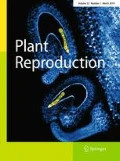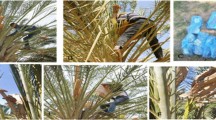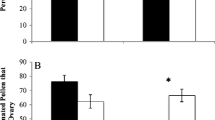Abstract
To determine the effects of soil phosphorus on pollen production, pollen grain size, phosphate concentration per pollen grain, and the siring ability of pollen, two cultivars of the common zucchini (Cucurbita pepo) were grown under two soil phosphorus conditions in an experimental garden. Overall, soil phosphorus availability had a significant effect on reproductive output through the female function and on traits affecting the male function of plants (staminate flower production, pollen production per flower, and pollen grain size). In addition, pollen produced by plants in the high phosphorus soils had a higher phosphate concentration than pollen produced by plants in the low phosphorus soils. A pollen mixture experiment revealed that pollen produced by plants in the high phosphorus treatment sired significantly more seeds than pollen produced by plants in the low phosphorus treatment. This study showed that growing conditions such as soil phosphorus can influence the size of a pollen grain and its chemical composition, which, in turn, can affect its ability to sire mature seeds.
Similar content being viewed by others
References
Baker HG, Baker I (1979) Starch in angiosperm pollen grains and its evolutionary significance. Am J Bot 66:591–600
Brewbaker JL (1971) Pollen enzymes and isozymes. In: Heslop-Harrison J (ed) Pollen: development and physiology. Butterworth, London, pp 156–170
Cruzan MB (1990) Variation in pollen size, fertilization ability, and postfertilization siring ability in Erythronium grandiflorum. Evolution 44:843–856
Dickenson DB, Lin JJ (1986) Phytases of germinating Lily pollen. In: Mulcahy DL, Mulcahy GB, Ottaviano E (eds) Biotechnology and ecology of pollen. Springer, New York Berlin Heidelberg pp 357–362
Dixon WJ (1990) BMDP statistical software Manual. vol 1. University of California Press, Berkeley
Freeman DC, Vitale JJ (1985) The influence of environment on the sex ratio and fitness of spinach. Bot Gaz 146:137–142
Hammer RD, O'Brien RG, Lewis RJ (1987) Temporal and spatial soil variability on three forested landtypes on the mid-Cumberland Plateau. Soil Sci Soc Am J 51:1320–1326
Harper JL (1977) Population biology of plants. Academic Press, London
Helsper JFG, Linskens HF, Jackson JF (1984) Phytate metabolism in petunia pollen. Phytochemistry 23:1841–1845
Jackson JF, Jones G, Linskens HF (1982) Phytic acid in pollen. Phytochemistry 21:1255–1258
Jackson JF, Linskens HF (1982) Phytic acid in Petunia hybrida pollen is hydrolyzed during germination by phytase. Acta Bot Neerl 31:441–447
Jaramillo VJ, Detling JK (1992) Small-scale heterogeneity in a semi-arid North American grassland. I. Tillering, N uptake and retranslocation in simulated urine patches. J Appl Ecol 29:1–8
Jaramillo VJ, Detling JK (1992) Small-scale heterogeneity in a semi-arid North American grassland. II. Cattle grazing of simulated urine patches. J Appl Ecol 29:9–13
Kumar D, Sarkar KR (1980) Correlation between pollen diameter and rate of pollen tube growth in maize (Zea mays L). Indian J Exp Biol 18:1242–1244
Lau TC, Stephenson AG (1993) Effects of soil nitrogen on pollen production, pollen grain size, and pollen performance in Cucurbita pepo (Cucurbitaceae). Am J Bot 80:763–768
Lee TD (1988) Patterns of fruit and seed production. In: Lovett Doust J, Lovett Doust L (eds) Plant reproductive ecology: patterns and strategies. Oxford University Press, New York, pp 179–202
Littell RC, Freund RJ, Spector PC (1991) SAS system for linear model, 3rd edn. SAS Institute, Cary
Mascarenhas JP (1989) The male gametophyte of flowering plants. Plant Cell 1:657–664
Mengel K, Kirkby EA (1982) Principles of plant nutrition, 3rd edn. International Potash Institute, Worblaufen-Bern
Moore PD (1992) Pastoral plumbing. Nature 357:644
Parrish JAD, Bazzaz FA (1985) Nutrient content of Abutilon theophrasti seeds and the competitive ability of the resulting plants. Oecologia 65:247–251
Quesada M, Schlichting CD, Winsor JA, Stephenson AG (1991) Effects of genotype on pollen performance in Cucurbita pepo. Sex Plant Reprod 4:208–214
Quesada M, Bollman K, Stephenson AG (1994) Leaf damage decrease pollen production and hinders pollen performance. Ecology (in press)
Roach DA, Wulff RD (1987) Maternal effects in plants. Annu Rev Syst Ecol 18:209–236
SAS (1990) SAS/STAT User's guide, version 6. 4th edn, vol 2. SAS Institute, Cary
Schlichting CD (1986) Environmental stress reduces pollen quality in Phlox: compounding the fitness deficit. In: Mulcahy DL, Mulcahy GB, Ottaviano E (eds) Biotechnology and ecology of pollen. Springer, New York Berlin Heidelberg pp 483–488
Scott-Wendt J, Chase RG, Hossner LR (1988) Soil chemical variability in sandy ustalfs in semiarid Niger, West Africa. Soil Sci 145:414–419
Stanley RG, Linskens HF (1974) Pollen: biology, biochemistry, management. Springer, New York Berlin Heidelberg
Stanton ML, Preston RE (1986) Pollen allocation in wild radish: variation in pollen grain size and number. In: Mulcahy DL, Mulcahy GB, Ottaviano E (eds) Biotechnology and ecology of pollen. Springer, New York Berlin Heidelberg pp 461–466
Steer MW, Steer JM (1989) Pollen tube tip growth. New Phytol 111:323–358
Stephenson AG (1981) Flower and fruit abortion: proximate causes and ultimate functions. Annu Rev Syst Ecol 12:253–279
Stephenson AG, Winsor JA, Schlichting CD (1988) Evidence for non-random fertilization in the common zucchini, Cucurbita pepo. In: Cresti M, Gori P, Pacini E (eds) Sexual reproduction in higer plants. Springer, New York Berlin Heidelberg, pp 333–338
Stephenson AG, Lau TC, Quesada M, Winsor JA (1992) Factors that affect pollen performance. In: Wyatt R (ed) Ecology and evolution of plant reproduction: a new approach. Chapman and Hall, New York, pp 119–136
Tabachnick BG, Fidell LS (1989) Using multivariate statistics, 2nd edn. Harper and Row, New York
Vasek FC, Weng V, Beaver RJ, Huszar CK (1987) Effects of mineral nutrition on components of reproduction in Clarkia unguiculata. Aliso 11:599–618
Watanabe FS, Olsen SR (1965) Test of an ascorbic acid method for determining phosphorus in water and NaHCO3 extracts from soil. Soil Sci Soc Proc 29:677–678
Wetzel CLR, Jensen WA (1992) Studies of pollen maturation in cotton: the storage reserve accumulation phase. Sex Plant Reprod 5:117–127
Willing RP, Bashe D, Mascarenhas JP (1988) An analysis of the quantity and diversity of messenger RNAs from pollen and shoots of Zea mays. Theor Appl Genet 75:751–753
Willing RP, Mascarenhas JP (1984) Analysis of the complexity and diversity of mRNAs from pollen and shoots of Tradescantia. Plant Physiol 75:865–868
Williams EG, Rouse JL (1990) Relationships of pollen size, pistil length and pollen tube growth rates in Rhododendron and their influence on hybridization. Sex Plant Reprod 3:7–17
Willson MF, Burley N (1983) Mate choice in plants: tactics, mechanisms and consequences. Princeton University Press, Princeton
Young HJ (1992) Environmental effects on pollen characters and paternity. In: Ottaviano E, Mulcahy DL, Sari Gorla M, Mulcahy GB (eds) Angiosperm pollen and ovules. Springer, New York Berlin Heidelberg, pp 445–450
Young HJ, Stanton ML (1990a) Influence of environmental quality on pollen competitive ability in wild radish. Science 248:1631–1633
Young HJ, Stanton ML (1990b) Temporal patterns of gamete production within individual of Raphanus sativus. Can J Bot 68:480–486
Author information
Authors and Affiliations
Rights and permissions
About this article
Cite this article
Lau, TC., Stephenson, A.G. Effects of soil phosphorus on pollen production, pollen size, pollen phosphorus content, and the ability to sire seeds in Cucurbita pepo (Cucurbitaceae). Sexual Plant Reprod 7, 215–220 (1994). https://doi.org/10.1007/BF00232740
Received:
Accepted:
Issue Date:
DOI: https://doi.org/10.1007/BF00232740




